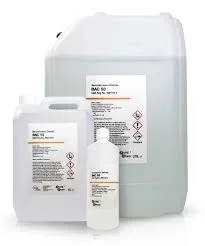Exploring the Uses and Safety of Isothiazolinones in Various Industries
Exploring Isothiazolinones Versatile Preservatives in Modern Applications
Isothiazolinones are a class of heterocyclic compounds widely recognized for their potent antimicrobial properties. These chemical compounds have garnered significant attention in various industries, from cosmetics and personal care products to industrial applications and even marine environments. As we delve into the world of isothiazolinones, we will explore their chemical structure, applications, regulatory considerations, and potential health effects.
The basic structure of isothiazolinones includes a five-membered ring with both sulfur and nitrogen atoms, which contribute to their unique reactivity and efficacy as biocides. The two most commonly used isothiazolinones are methylisothiazolinone (MIT) and chloromethylisothiazolinone (CMIT). These compounds are often used in combination to enhance their preservative action, making them a popular choice in formulations requiring protection against microbial growth.
One of the primary applications of isothiazolinones is in the cosmetics and personal care industry, where they serve as preservatives to extend the shelf life of products such as lotions, shampoos, and makeup
. Their effectiveness against bacteria, fungi, and yeast makes them invaluable in preventing spoilage, ensuring that products remain safe for consumers. However, the use of isothiazolinones in cosmetics has raised concerns due to reports of allergic reactions and skin sensitization, prompting regulatory bodies to review their safety.isothiazolinones

In the industrial sector, isothiazolinones play a crucial role in the formulation of paints, coatings, and adhesives. They help prevent microbial contamination during production and storage, ensuring the durability and performance of these materials. Additionally, their application in cooling water systems and oilfield operations showcases their versatility, providing effective control over biofouling and microbial corrosion.
Despite their broad application and efficacy, the use of isothiazolinones is subjected to increasing scrutiny. Regulatory agencies worldwide, including the European Union and the United States Environmental Protection Agency (EPA), have established guidelines for their concentration in products, and several have implemented bans or restrictions on their use in cosmetics due to the potential risks they pose to human health. This regulatory evolution is largely driven by growing public awareness and scientific research highlighting the potential for sensitization and dermatitis caused by these compounds.
The health effects associated with isothiazolinones are a significant concern. Skin irritation and allergic reactions are the most commonly reported issues, particularly with chronic exposure. Sensitization can occur even at low concentrations, leading to long-term allergic responses in some individuals. This has sparked debate in various industries about the responsible use of isothiazolinones and the quest for safer alternatives. Many manufacturers are exploring botanical preservatives and other natural alternatives to address consumer demand for safer, eco-friendly products.
In conclusion, isothiazolinones are vital compounds in a multitude of industries due to their effective antimicrobial properties. However, with their widespread use comes the responsibility of evaluating their safety and efficacy. As research progresses and regulations evolve, consumers and manufacturers alike must remain informed about the potential impacts of these compounds. The balance between maintaining product integrity and ensuring consumer safety will continue to shape the future of isothiazolinones and their role in modern applications. As we seek out sustainable and safe alternatives, the conversation around isothiazolinones serves as a reminder of the complexities involved in chemical usage and consumer safety in an ever-evolving marketplace.
-
Understanding Polycarboxylic Acids: Properties, Applications, and Future PotentialNewsJul.28,2025
-
Scale Inhibitor Explained: How to Protect Your System from Limescale and Hard Water DamageNewsJul.28,2025
-
Scale and Corrosion Inhibitors: Essential Chemicals for Industrial Water System ProtectionNewsJul.28,2025
-
Polyaspartic Acid: A Biodegradable Polymer for Sustainable ChemistryNewsJul.28,2025
-
Isothiazolinones: A Versatile Antimicrobial Class with Industrial Power and Regulatory ChallengesNewsJul.28,2025
-
A Deep Dive into 2-Phosphonobutane-1,2,4-Tricarboxylic Acid (PBTC)NewsJul.28,2025





